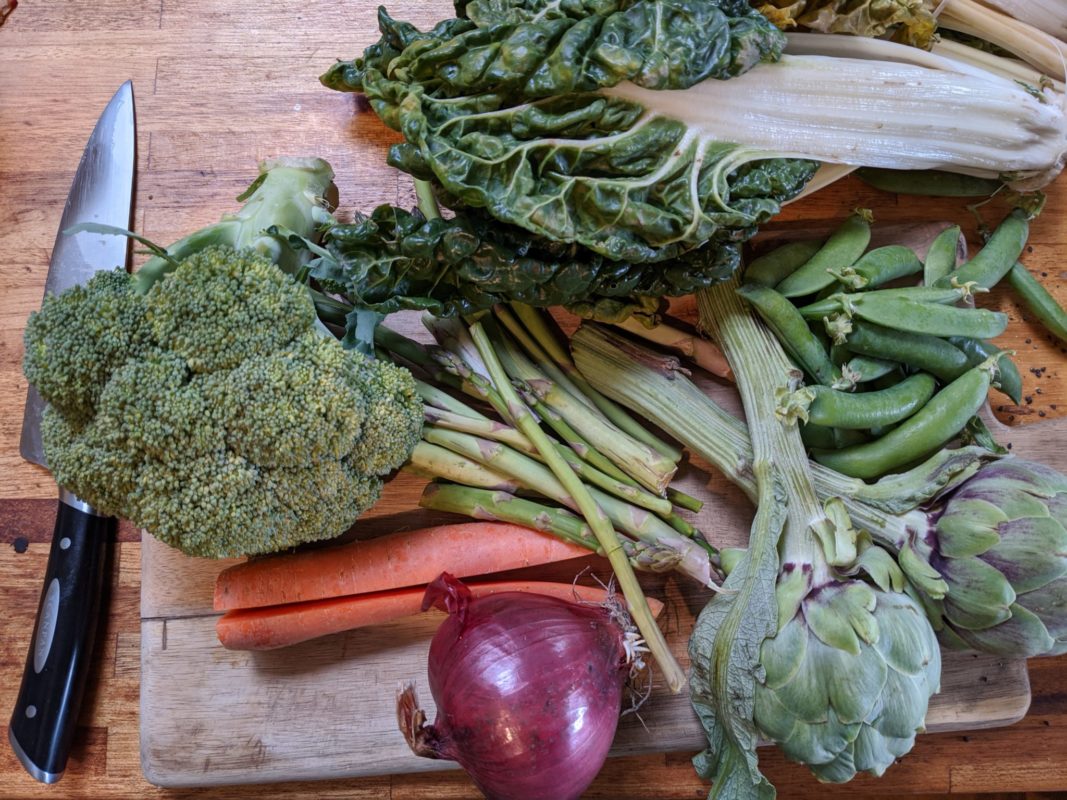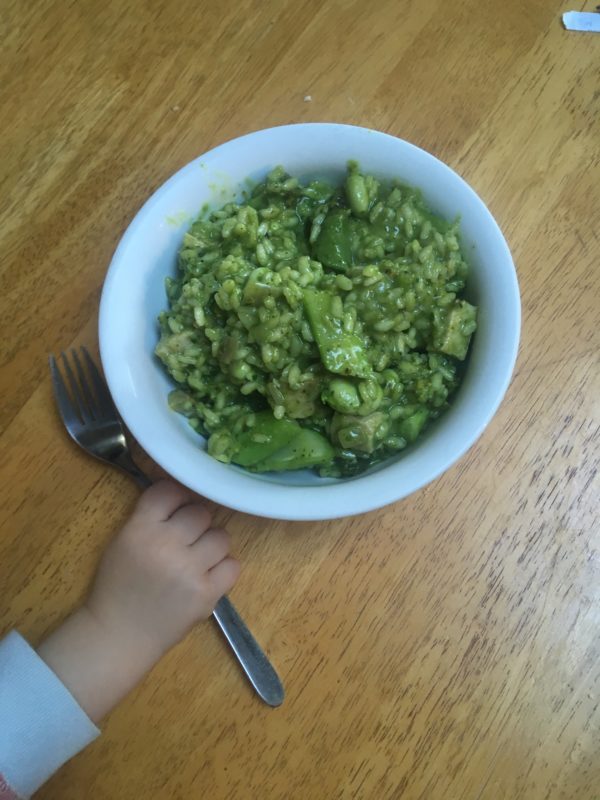Risotto is a ubiquitous dish in our household- it’s simple, filling, takes only half an hour and I always have the necessary ingredients. Traditional risotto usually features autumn veggies (pumpkin or mushrooms) but you can make a beautiful dish using the bounty of spring. Tonight’s used silverbeet, shelling peas, asparagus brocolli and silverbeet. But substitutions and experimentation are encouraged.
Ingredients
- 1 onion (I used red tonight, but brown is fine. If you don’t have either- after all they’re bolting at the moment, use spring onions, or leeks)
- 1 large carrot, or 2 dutch
- 2 cups of arborio rice (or any rice- just take into account the longer cooking time of brown rice)
- 3 cups of stock
- 1 lemon or lime
- a slug of white wine if you’re so inclined (I usually am!)
- Cheese- whatever you have in the fridge; parmesan, cheddar, feta- choose your own poison and season to taste
- salt and pepper
- Spring Vegetables-I used 2 artichokes, trimmed to their hearts and quartered, 1 large brocolli head, 250g of shelling peas (I often set my son to shelling while I cook), 250g of asparagus and a large bunch of silverbeet.

HOWEVER, please don’t feel limited by this list. I have successfully used kale, bok choy, silverbeet, spinach and parsley. I’ve tried snowpeas, broadbeans and green garlic. The trick with choosing your vegetables is remembering how long each takes to cook, so assemble them before you start, and place them in order. If you haven’t used the ingredient before, a quick internet search (we use ecosia as they plant trees on our behalf!) for their cooking time will help you out. Overcooked spring risotto is mushy and dull. Perfectly done, is vivid, tender and has all the freshness and light of Spring.
Method
- Dice your onion (or leek) and carrot, and set sizzling in a large pot. If you have any celery stalks chop them fine and add. If you have cured garlic left over still, or some in your freezer add it now. If you are using spring onions or spring garlic, hold til later and begin by just frying off the carrot.
- While it is cooking, heat you stock in separate pan. Or, boil the kettle, and hold your stock powder at the ready 🙂
- Once the onion is translucent and softened (or the carrot has cooked for 5-10 minutes if you aren’t using onion), add a knob of butter, and your 2 cups of rice. Stir while frying, and watch for the rice to turn translucent.
- Add the glug of wine. Pour yourself a glass as well.(By adding the wine early you ensure than the alcohol evaporates away, so your final meal is 100% child friendly)
- Once the wine is absorbed, add your first cup worth of stock. As you add any liquid to the pot, you are wanting to hear a massive sizzle. And as you make those first few stirs, you want it to really make some noise. If it doesn’t, you’ve added the liquid too early. Wait longer next time- until the pan looks quite dry.
- Ideally for risotto, you should be stirring almost constantly, to enhance the smooth and creamy texture. But I am no Jamie Oliver, so 80% of the time I am juggling a child, washing dishes, or chopping up my next ingredient 🙂 I just stick the lid on and stir/check periodically. If you are stirring and have the lid off, expect to use an extra cup of stock (and 15% more energy!).
- Once the liquid has been fully absorbed, I add another cup of stock, and I start thinking veggies.
- You want to add your veg so that everything is ready at the same time. I know my risotto takes 30 minutes after the rice is added. If you’ve been stirring, you’ll have a nicer, creamier risotto, but it’ll also take an extra 5 minutes or so. If you’ve used brown rice, make sure you’ve left 40-45 minutes.
- I add artichoke hearts first- I trim them hard, down to the heart, and put them in 20 minutes before finish time (10 minutes after I add the rice).
- I wash my greens and slice them finely. Depending on what they are, depends on how I treat them. Parsley, spinach or silverbeet I squish into the remaining cup of stock, and I blitz them with a stick mixer. I had these to the risotto with 5 minutes to go. Kale or other tough greens like chicory I steam for approximately 8 minutes before I blitz them. You don’t need to if you’re ok with a chunkier liquid, or if you have a powerful blender. But I find it helps to break them up, and give a brighter smoother end product. If you have used spring onions or green garlic, I tend to slice finely and add to the blitz.
- I add broccoli about 10 minutes before the risotto should be ready (20 minutes after the rice went in), but I cut it very coarse because my nearly 3 year old likes to pretend he’s a Diplodocus. If you cut in normally, add it 6 minutes before the end. I break the bottom inch off my asparagus chop roughly into thirds and add 4 minutes before. I give freshly shelled peas 3 minutes.
- While I’m waiting my final few minutes I grate cheese and shove the mess off the table.
- I season the risotto with salt and pepper, squeeze over some lemon or lime juice, and serve. We add our own cheese in our household, but you can easily stir through with the salt and pepper if you prefer.
This recipe should make enough for 4 people, and depending on your tweaks is around 5 of the 7 required daily serves of veggies for each of them! Enjoy, and let me know what spring veggies you like in your risotto!
PS Matt has reminded me that if you are using bigger broad beans, you should double pod them. Once he did not, and I have never let him forget it!

